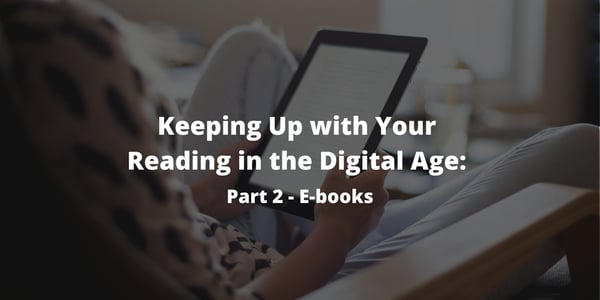In Part 1 of this two-part blog series (Audiobooks - click here), I commented on my love of books...
Keeping Up with Your Reading in the Digital Age: Part 1 - Audiobooks
I love books. You'll notice I didn't start out saying, "I love to read," which I definitely do. However, the act of holding a book in my hands or even looking at books on a shelf delights me. I relish having books surround me, which explains why two of my favorite haunts are libraries and bookstores. In fact, when traveling, I have my picture taken in a local bookstore as a souvenir of the trip.
So, I am not inclined to favor books in digital formats: ebooks and audiobooks. However, even though traditional books remain my passionate first love, these non-physical versions and I have developed a close platonic relationship. In this two-part series, I'll cover the ins and outs of each type. First up, audiobooks.
Audiobooks – From Modest Beginnings to Explosive Growth
Audiobooks have been around for a while. They emerged in the 1930s on vinyl records intended for those with visual impairments. However, the vinyl format was limited to about 20 minutes of content per record.
By the 1960s, books were offered on cassette tapes, which could hold much more information. Unabridged books could be recorded on a reasonable number of cassettes, thereby causing the format to catch on with a general audience. In the 1980s, audiobook growth increased yet again when cassettes gave way to compact disks, and portable players were more widely available. The audiobook revolution entered a new era in the early 1990s when the Audible brand debuted a digital download product for personal computers. By 1997, Audible offered a dedicated portable playback device. Fast forward to the current era: in 2018, around 50,000 audiobooks were recorded in the U.S. with a 20% annual growth rate driven primarily by the explosive growth of smartphones and tablets.
The audiobook revolution entered a new era in the early 1990s when the Audible brand debuted a digital download product for personal computers. By 1997, Audible offered a dedicated portable playback device. Fast forward to the current era: in 2018, around 50,000 audiobooks were recorded in the U.S. with a 20% annual growth rate driven primarily by the explosive growth of smartphones and tablets.
Audiobooks Today
So, what motivated me, the book lover, to add audiobooks to my repertoire? Unlike books or ebooks, audiobooks cater to the multitasker. For example, I enjoy listening to audiobooks when I exercise. A brisk, one-hour walk goes by quickly as I listen to a great novel or a stimulating work of non-fiction. I also listen in the car, even on short trips. Gardening or mowing the lawn offers more occasions for listening.
Before I became a friend of audiobooks, I needed to find the right method to consume them.
Audiobooks can be purchased, rented, or borrowed for free. As for buying, once you pay, you own the book forever. If you anticipate re-listening to a book, purchasing could be your best bet. However, an audiobook purchased individually often costs more than the hardcover print version. For example, Devoted by Dean Koontz in hardcover sells for $18.99 on Amazon, but the audiobook version is $25.99. That is unless you subscribe to Amazon's Audible service. Once signing up for a 30-day trial offer, you get two free audiobooks plus one free Audible Original. Audible Originals are produced only as audiobooks and sold exclusively on Audible. After the trial period, you pay $14.95 per month, which entitles you to one regular audiobook and one Audible Original per month. You can cancel anytime and keep the audiobooks.
Audible is not the only game in town. There are other options for getting audiobooks, both free and not free. Iris Yan recently published a good summary of the alternatives on epubor.com. One free option she mentions is OverDrive, which is offered through over 30,000 libraries. The app that plays Overdrive audiobooks and ebooks is called Libby. After you download Libby to your smartphone or tablet, look up your local library and enter your username and password. .png?width=600&name=image3%20(1).png)
With Libby, you can scan for audiobooks and ebooks across genres and see new or popular titles. Since these are library books, publishers limit the number of available book copies per library. So, just as with physical books, you often must wait for popular titles. Nevertheless, it's easy to reserve an audiobook. When available, you are notified that it is ready to be downloaded.Also, like physical books, you borrow an audiobook for a set period. It can be renewed if no one else is waiting. However, suppose someone is waiting for the audiobook, and you reach the borrowing deadline. In that case, the title automatically deletes from your device, thereby "returning" it to the library.
The Libby app shows how many hours and minutes it will take to complete listening to the book when playing an audiobook. Libby will also show how many minutes remain before the end of a chapter. If you missed something while listening, you can back up 15 seconds. You can also skip ahead 15 seconds.
The playback speed on Libby can be adjusted. The playback can be slowed down to 60% of normal speed or sped up to twice normal speed. I like to set the playback speed to 125%. The reader's voice is very understandable at that speed and allows me to complete a book faster. I've sped it up faster sometimes when the return deadline is looming.
If you like listening to a book at bedtime, there is a sleep timer that will stop the book after a set amount of time or at the end of a chapter.
One of the downsides to audiobooks is the inability to highlight an interesting passage. You can set a bookmark and make a note, but, to me, this is not as satisfying as desecrating a book with a handy yellow highlighter. Also, a dictionary is often not handy when I want to look up a word I don't know.
Addition, Not Replacement
My book obsession remains intact despite my enthusiastic adoption of the audiobook format. Yet, in the last seven months, I've completed 19 audiobooks and four physical books. So, when it comes to the sheer volume of words, audiobooks wins the contest convincingly.
This is Part 1 of the Keeping up with Your Reading in the Digital Age blog series. Subscribe to our blog to receive future posts straight to your inbox!






